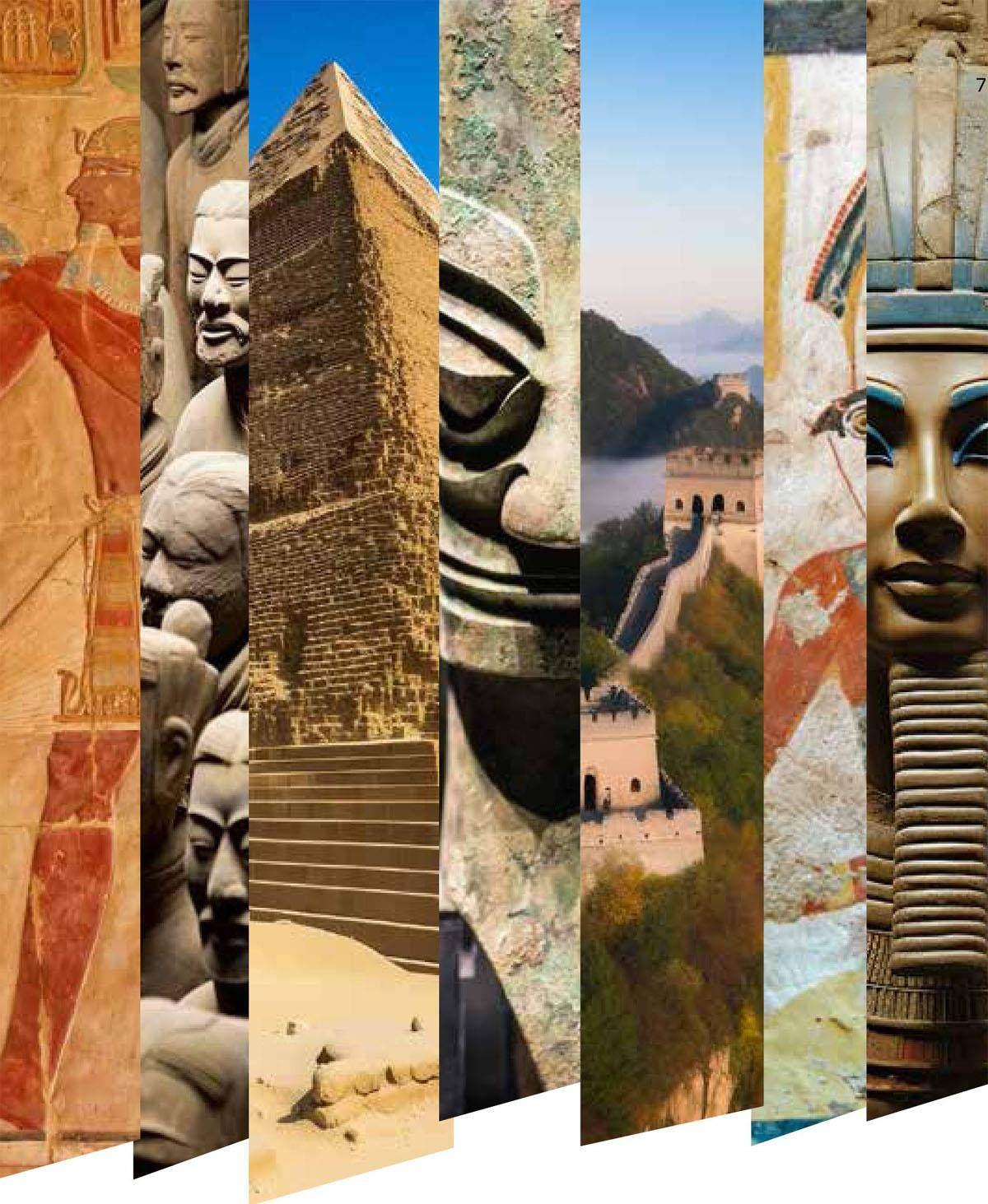如何教好文化课Effective Strategies for Teaching Cultural Studies
黄艳红 Huang Yanhong



“中國文化与文明”是埃及各大学中文系的一门必修汉语课程,是外国学生了解中国璀璨文化的窗口。
“Chinese Culture and Civilization” is as a compulsory Chinese languagecourse taught at the Chinese departments of Egyptian universities. Thiscourse acts as a gateway for students learn the rich tapestry of Chineseculture.
在多年的教学实践中,我慢慢甄选出适合埃及学生学习的内容,摸索出一套他们喜闻乐见的教学方法——中埃传统文化比较法。以下就举几个例子说明。
Drawing from years of teaching experience, I have curated contenttailored to the learning needs of Egyptian students. I have also developedan engaging and enjoyable teaching methodology, known as the Sino-Egyptian Traditional Culture Comparative Approach. Allow me to offer afew illustrative examples.
中埃传统节日的代表:春节和闻风节Traditional Festivals: The Chinese Spring Festival and Egyptian Sham El-Nessim
同出自农耕文明,古代中国人和埃及人都根据自己对天体和自然界的观察,制定了完善的历法,并根据日历来安排农事。所不同的是,中国的农历是阴阳合历,即日月合历;古埃及的历法则是太阳历。中国的春节和埃及的闻风节都是庆祝春天来临、万象更新的重要节日。
Rooted in agrarian civilizations,both ancient Chinese and Egyptiansdevised intricate calendars basedon their observations of celestialbodies and the rhythms of thenatural world. Both use thesecalendars to plan their agriculturalendeavors. The notable distinctionlies in their calendar types, as Chinaemploys a calendar that combines thelunar and solar cycles, while ancient Egyptutilizes a solar calendar. As important festivals,both the Chinese Spring Festival and Egyptian ShamEl-Nessim celebrate the arrival of spring and therenewal of life.
教授中国传统节日的课程,主要侧重四个方面:时间、来历(背景)、习俗和饮食。
In my course on Chinese traditional festivals, Iplace particular emphasis on four key facets: timing,origin (historical context), customs, and cuisine.
春节的时间是农历的正月初一至十五,一般称“过年”,是新一年的开始。关于春节的来历,除了历法背景,我还特意介绍了和春节有关的民间传说,从扫尘,贴春联、福字、窗花、年画,到燃放烟花爆竹、守岁和拜年,我结合图片和短视频一项一项地仔细讲解,同学们觉得非常新奇有趣。接下来的重头戏就是春节的饮食了——北方的饺子、南方的年糕让学生们垂涎欲滴。去过中国餐厅的学生趁机炫耀,没去过的学生则迫不及待地想去亲口尝一尝这些中华美食。
The Spring Festival falls on the first day to thefifteenth day of the f irst lunar month. Commonlyknown as “Guo Nian,” it marks the beginning ofa new year. In explaining the origin of the SpringFestival, apart from its historical background, I alsodelved into the folklore associated with the festival.From the rituals of spring cleaning, the hangingof couplets and auspicious symbols, the display ofwindow decorations and Spring Festival paintings, tothe exuberant practices of setting off fireworks andfirecrackers, staying up late on Lunar New Years Eve,and paying New Year visits, I illustrated each traditionusing pictures and short videos, which the studentsfound fascinating. Undoubtedly, the highlight ofthe course was the discussion of the Spring Festivalcuisine, which includes northern dumplings andsouthern rice cakes, delicacies that invariably leavestudents mouths watering. Those fortunate enoughto have dined at Chinese restaurants took theopportunity to share their experiences, while otherseagerly anticipated the opportunity to savor theseChinese dishes for themselves.
之后,我把话题转到了埃及的“闻风节”,请学生仿照我介绍春节的方式介绍他们的传统节日,要求必须跟春节的知识一一对应着讲述。学生们以小组为单位,共同完成了下方的表格。
Afterwards, I shifted the topic to Egyptian Sham El-Nessim and asked the students to introducetheir traditional festivals just like what I did with the Chinese Spring Festival. I emphasized that theyshould make sure to explain each aspect of their festival in relation to what we had discussed aboutthe Spring Festival. The students worked in groups to complete the table below.
通過比较的方式,学生们不但轻松掌握了中国春节的相关知识,而且系统总结出两个节日的特点,主动学习了很多新词,可谓是“一举多得”。
Through the process of comparison, students not only effortlessly grasped relevant knowledgeabout the Chinese Spring Festival but also systematically summarized the characteristics of twofestivals. They proactively learned many new words, making it a win-win situation.
中埃古代发明的代表:蔡侯纸和莎草纸Ancient Inventions: Caihou Paper and Papyrus
中国和埃及同为世界文明古国,其文化的载体——纸的发明自然不可或缺。
As ancient civilizations, both China and Egyptmade a pivotal contribution that served as a mediumof their cultures: the invention of paper.
在造纸术发明以前,人们多用竹简、羊皮和锦帛等记录文字,但这些东西不是沉重就是昂贵,只有少数人用得起,极大地限制了文化和信息的传播。中国东汉时期的蔡伦总结前人的经验,改进造纸工艺,以树皮、破布、麻头、旧鱼网等植物纤维为原料,造出了成本低、质量高的“蔡侯纸”,并很快实现了大范围推广。这种造纸工艺一直沿用至今,对世界造纸业的发展和人类文明的传播具有深远影响。
Before the invention of papermaking, peoplepredominantly used materials like bamboo slips,sheepskin, and silk to record information, but thesematerials were either heavy or expensive, makingthem accessible to only a few, significantly limitingthe dissemination of culture and information. Duringthe Eastern Han Dynasty in China, Cai Lun, buildingupon the knowledge of his predecessors, improvedthe papermaking process. He used plant f ibres fromtree barks, discarded cloth, hemp, and old fishingnets as raw materials, resulting in the creation of“Caihou paper,” which was low in cost and high inquality. It was quickly adopted on a large scale. Thispapermaking technique has been in use ever since and has had a profound impact on the developmentof the global paper industry and the dissemination ofhuman civilization.
古埃及记录文字使用的是莎草纸, 并持续使用了3 000多年,记录了古埃及、古希腊和古罗马的历史和成就。莎草纸虽然叫“纸”,但事实上并非真正的纸,反而更接近竹简,只是它的制作工艺要复杂很多,也比竹简轻巧。莎草纸的原材料是盛产于尼罗河流域的一种叫作莎草的植物,与蔡伦造纸的原材料一样,有着廉价易得的优点。莎草纸大约出现在公元前3000年,蔡侯纸则出现在约公元105年。现代纸张的定义是把植物纤维打碎后重组,莎草纸则是植物纤维的拼接。如今,莎草纸画是来埃及的外国游客必购纪念品之一,被称作古埃及文明的“活化石”。教授这一内容时,我请学生带上莎草纸来课堂,通过将其与现代纸张对比帮助他们感知和理解它与中国蔡侯纸的区别。我还给学生布置了课后作业,让他们将废纸、包装盒等当作原料,仿照蔡伦造纸的方法制作纸张,并完成表格的填写。学生们都觉得有趣极了,轻松愉快地就掌握了所学的知识。
Ancient Egypt utilized a writing material calledpapyrus, which remained in use for over 3,000 yearsas a means to record the history and accomplishmentsof ancient Egypt, Greece, and Rome. Althoughreferred to as “paper,” papyrus differed significantlyfrom what we typically associate with paper today;its composition was more akin to bamboo slips.While its production process was intricate, itresulted in a lighter material than bamboo slips.Papyrus was crafted from the papyrus plant, whichthrived in the Nile River region — similar to theplant material used by Cai Lun, chosen for itsaffordability and accessibility. Papyrus dates backto around 3000 BC, preceding the emergenceof Caihou paper at around 105 AD. The keydistinction between modern paper and papyrus liesin their manufacturing processes: modern paperinvolves breaking down and reassembling plantfibers, while papyrus is more akin to a patchworkof plant fibers. Today, papyrus art serves as oneof the essential souvenirs for tourists visitingEgypt, often celebrated as a “living relic” of ancientEgyptian civilization. When teaching this topic, Iencouraged students to bring papyrus to class andasked them to conduct a comparative analysis ofpapyrus and Caihou paper. Additionally, I assignedhomework tasks in which students used materialslike wastepaper and cardboard boxes to createpaper using Cai Luns method and completed acomparative analysis table. This approach greatlypiqued students interest and enhanced theircomprehension of the subject matter.
此外,中国传统文化中的中医理论与古埃及的草药使用理论和防腐技术,中国传统建筑与古埃及建筑,中国的“儒释道”三教一体信仰体系与古埃及的多神信仰,中国的甲骨文与古埃及的象形文字,等等,两个文明在很多方面都存在可比性。
Moreover, numerous parallels exist betweentraditional Chinese and ancient Egyptian cultures.These include similarities in areas such as the theoriesof traditional Chinese medicine and ancient Egyptsutilization of herbs, preservation techniques, traditionalChinese architecture and ancient Egyptian architecture,the integrated belief systems of Confucianism,Buddhism, and Taoism in China and the polytheisticbeliefs of ancient Egypt, and the Chinese oracle bonescript and ancient Egyptian hieroglyphs.
用比較法教授这门课程,不但激发和培养了学生对中国文化的兴趣,鼓励学生主动去阅读、了解和探索,而且让学生懂得应客观看待和评价世间的万事万物,不妄自尊大,也不妄自菲薄,以自身文化为根本,进行互鉴、互赏,促进对彼此文化的了解和包容。如此,人类文明才可以继续在融合中发展和进步。
By employing comparative methods in teachingthis course, we not only ignite and cultivatestudents fascination with the Chinese culture butalso motivate them to actively engage in reading,exploration, and comprehension. Furthermore, itinstills in students the value of objectively assessingthe world, free from excessive arrogance or selfdeprecation.This approach underscores the pivotalrole of ones own culture as a bedrock for fosteringmutual appreciation and cross-cultural learning,thereby nurturing understanding and toleranceamong diverse cultures. In doing so, we contribute tothe evolution and advancement of human civilizationthrough harmonious integration.
供图/ 黄艳红

